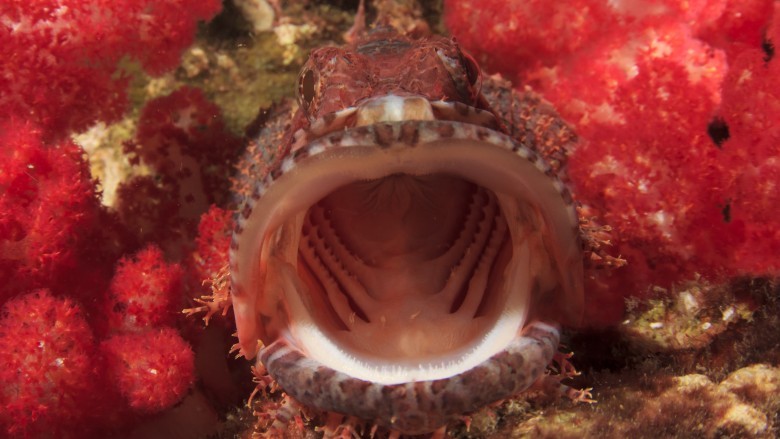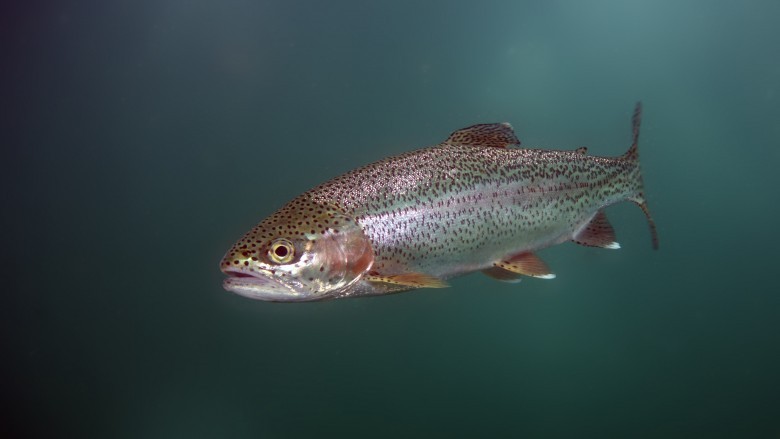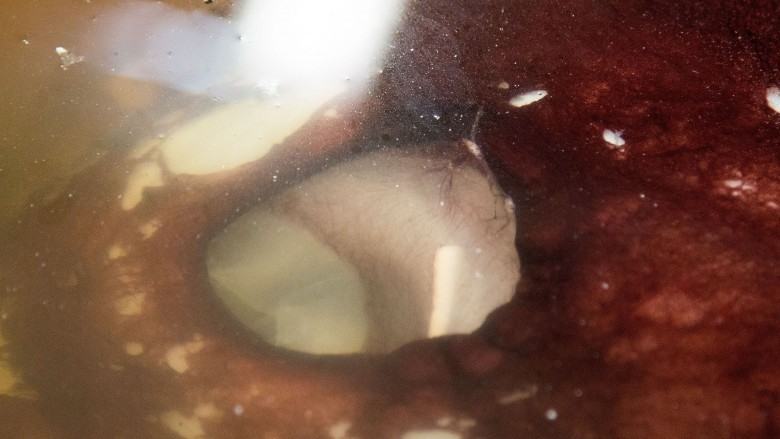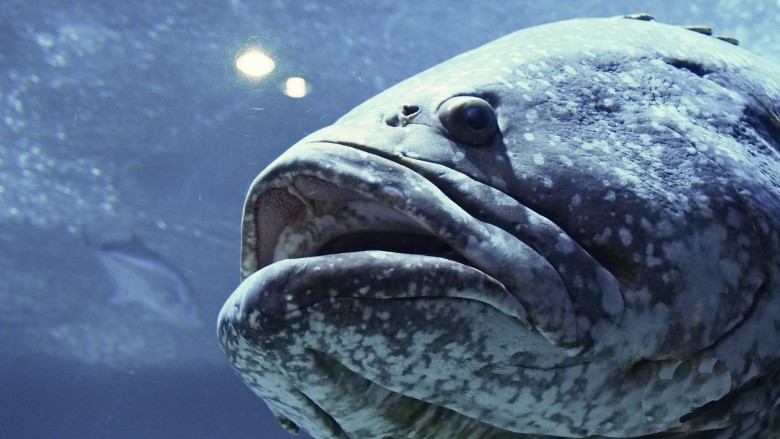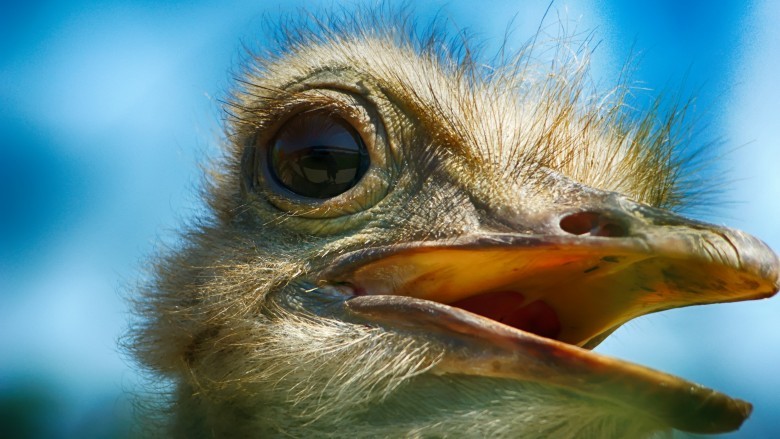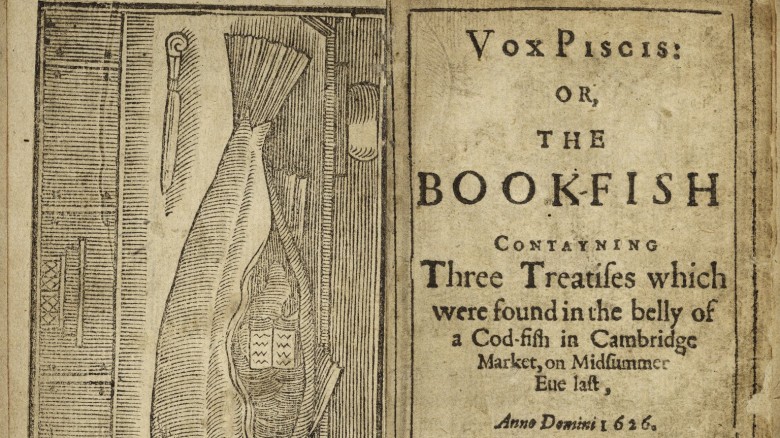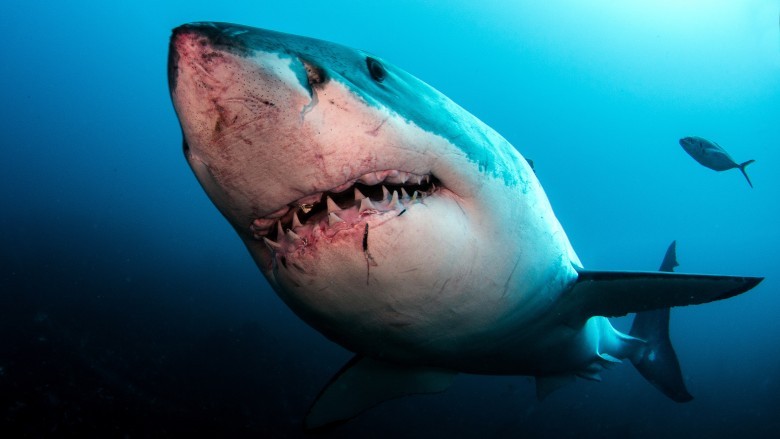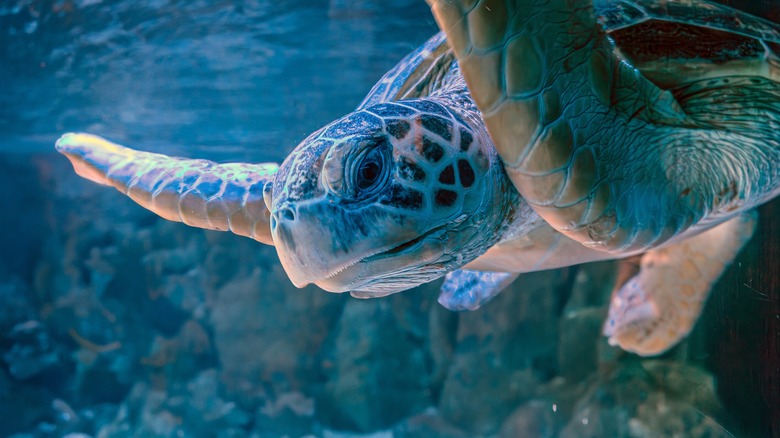Strangest Things Found In Animals' Stomachs
Our animal friends sometimes eat something they shouldn't, especially dogs, who seem to swallow everything from socks to Homer Simpson. But wild animals have also been found with bizarre things in their bellies: documents, new species, and even the human implements of love and war.
Fingers in trout
In July 1991, 32-year-old Robert Lindsey was at the Flaming Gorge Reservoir in Wyoming when he suffered a terrible hand injury. He had dived from a boat to help a friend's daughter when she fell into the water but ended up losing three fingers to the boat's propeller. Two of the digits were found and reattached, but his thumb was lost. At least until six months later, when a fisherman in the nearby Green River found a human thumb in the belly of a trout. Lindsey contacted the local coroner, who was able to confirm the digit did indeed belong to him. By this stage, Lindsey was in pretty good humor about the situation, telling the media, "I'll probably just put it on a shelf to show people. I'll probably keep it in a jar."
You might be forgiven for thinking this was a one-off incident, but in 2012, something similar occurred. Haans Galassi lost four fingers in an unlucky accident at an Idaho lake when a rope he was using to wakeboard wrapped around his hand, and he ended up dragged in the water. Two months later, fishermen discovered a human little finger in the belly of a large trout. Thanks to the frigid cold conditions of the lake, the finger was in remarkable condition. The sheriff's office was able to trace the mysterious digit to Galassi through fingerprint records. Galassi initially had no interest in reuniting with his lost finger, so the sheriff left it on ice in the evidence locker just in case he changed his mind.
The squid bomb
In 2013, a fishmonger in southern China known as Mr. Huang got a potentially explosive surprise while gutting a squid for a customer. The 3-foot-long cephalopod had been caught in the shallow waters off the Guangzhou coast. While the squid usually live off a diet of small fish and shrimp, when Huang cut open this squid's distended belly, he found a live bomb, weighing in at three pounds and shaped like an eggplant. Huang quickly called the police, who took the rusty but still active bomb away and performed a controlled explosion.
They declined to speculate on the age of the bomb but suggested it may have been dropped from a fighter jet. Police warned residents to be wary of other explosives found in foodstuffs, though in this case it almost seems a missed opportunity. They could have found a quick and entertaining way for make grilled calamari.
The dildo cod
Fisherman Bjørn Frilund was gutting a 50-kilogram cod caught in the waters near his home town of Eidsbygda in western Norway when he noticed a large bump in its stomach. He reached in and pulled out two partially digested herrings and a large orange vibrator, which was definitely a first for the 64-year-old despite having fished in the area for as long as he can remember.
He speculated the cod may have mistaken the device for its usual preferred prey. He told The Local newspaper, "Fish eat all kinds of different things. And the dildo looks like what the fish eat. We have a kind of multi-colored octopus in Norway, maybe the cod thought this was one of these and ate it."
As for the origin of the device, which still had a small motor attached, Frilund suggested the dildo had been thrown off the side of a boat in the Barents Sea, possibly by "a frustrated woman on a cruise." No batteries were found in the cod, which seems important, somehow.
The dildo-fisken was filleted and given away, but as for whatever happened to the device itself, Frilund neglected to tell the media.
The newspaper in the sunfish
Back in December 1882, zoologist Edward Ramsay collected a massive 3-meter-tall sunfish out of the waters of Sydney Harbor. According to the 1931 Studies in Ichthyology, the giant fish had been first spotted by shipping and later somehow ran aground in black mud between vessels and the shallows. It was raised up to a wharf by crane where "some fools began to hack it about the head and pectoral fin with an axe and greatly mutilated it" before a foreman stepped in and had it sent to the Australian Museum.
The fish was gutted and stuffed then sent to London to be exhibited at the 1883 Great International Fisheries Exhibition before being donated to the London Museum. It later ended up in the basement of the Natural History Museum, where in 2016, curators performed a restoration on the inside of the Sunfish, which was splitting at the seams after 130 years. Along with the expected straw, the restorers discovered pieces of floor beams, the seat of a wicker chair, and a fragment from the January 26, 1883 edition of the Sydney Morning Herald.
Not only that, but the fish itself was mentioned in the 'Social' column of that very edition of the newspaper, so the fish was inside the newspaper that was inside the fish. Which again was inside the newspaper when the Herald in 2016 reported on it. We can only hope the curators kept the cycle going by adding a new fragment during the restoration, if only to amuse whoever in the 22nd century opens it up again.
A badge in a grouper
In April 2017, fisherman Arnold Constantino made the catch of his life when he landed a massive lapu-lapu or grouper fish in the Pandan municipality in the Philippines province of Antique. The fish was around 7 feet long and weighed in at over 200 kilograms, making it likely the largest such fish ever caught in the region.
There was an even bigger surprise after Constantino took the fish to a local market to be sliced up for sale. Fishmongers found a shiny gold security guard's badge inside the massive fish, immediately launching speculation the fish was a man-eater.
While it's much more likely the fish simply swallowed a badge that had been lost at sea, the possibility of a darker tale scared off some potential customers. According to Constantino, "Nobody knows why there was a badge inside. It caused some panic. Did it attack somebody, or swallow someone missing at sea? We are not sure ... Selling the fish was harder when traders thought it might have eaten a human. I had to take a lower price."
A shame. We're sure a certain type of buyer would pay an even higher price for that kind of fish.
A new ant was found in frog vomit
Research on wild frogs is a tricky business, as many amphibians are endangered. In 2016, researchers in Ecuador captured a diablito, or little devil frog (Oophaga sylvatica), a bright orange poison frog. They hoped to figure out how the frogs created the alkaline they used in chemical defenses and needed to see what the frog had eaten. To that end, they inserted a soft tube into the frog's mouth and filled it with water to cause whatever it had eaten recently to flow onto the tray.
After letting the hapless devil frog loose and turning to examine their hard-won amphibian vomit, the researchers made a remarkable discovery: an entirely undocumented species of ant, named Lenomyrmex hoelldobleri. While the scientists can't learn too much from a single dead ant, it was notable for its forceps-like mandibles, which the ants might use to pry smaller insects like termites out of small crevices. This is presumably the first time an undocumented new species with clashing jaws has erupted out of someone's stomach ... at least outside of a sci-fi horror movie.
The complicated contents of an ostrich
In 1930, one of the ostriches at the London Zoo died mysteriously, prompting an autopsy. The discovery of the contents of the poor ostrich's stomach was so bizarre that Zoological Society of London photographer Frederick William Bond saw fit to document them for posterity. The full contents of the ostrich's stomach were: "Three odd cotton gloves. Three handkerchiefs. The wooden center of a silk spool. A piece of lead pencil. Four halfpennies. One franc, one farthing. One coin too worn for identification. Part of a bicycle valve. Part of a metal comb. One piece of wood. Two yards of string. An alarm clock key. Several small metal washers and other pieces of metal. A four-inch nail." It was this last item that led to the animal's "death by perforation."
In the wild, ostriches consume their food whole and often swallow hard objects like stones and pebbles to act as gastroliths, allowing the birds to masticate the food in their gizzards. It's likely the ostrich was simply making do with the small hard objects that were available in the urban environment of the London Zoo, rather than a deliberate penchant for fashion items and coin collecting.
Religious manuscript found in a fish
In 1626, a cod cut open at the Cambridge market was discovered to contain an entire sextodecimal (twelve part) text wrapped in canvas, only partially digested. After examination, it was identified as several evangelical tracts published a century earlier during the reign of Henry VIII, attributed to the reformist martyr John Frith who had died at the stake in 1533. The text was published the following year under the title Vox Piscis: Or, The Book-Fish. Later scholars identified only two sections of the sextodecimel text as definitively belonging to Frith: the sections entitled "A mirrour, or, glasse to know thy selfe" and "A briefe instruction, to teach a person willingly to die, and not to feare death" were found to be a reprint from sections of Frith's "A letter wryten unto the faythful folowers of Christes Gospell," published in the late 1530s.
Frith's association with Vox Piscis was likely encouraged by a quirk of history: five years before Firth was burned at the stake for his beliefs, he'd been imprisoned in a fish cellar beneath Oxford University, where fumes from salted cod were said to have claimed the lives of many fellow reformists.
The published text even contained several examples of contemporary lame jokes from Cambridge scholars: "A young scholar, who had, in a stationer's shop, peeped into the title of the Civil Law, then viewing this unconcocted book in the cod-fish, made a quibble thereupon. Saying that it might have been found in the Code, but could never have entered into the Digest." Get it?
A whole doe inside a massive alligator
In 2014, Alabama taxidermist Ken Owens took his knife to an alligator of record size caught in the state's annual gator hunt, which clocked in at 15 feet long and 1,011.5 pounds. When he cut the beast open, he quickly spotted a pair of ears that turned out to be attached to an entire adult female deer, which was intact if somewhat worse for wear. Owens estimated the deer to have been around three years old, which would have put it at around 115 pounds in weight. The alligator had likely consumed the deer sometime within a week before it died: the doe's fur and much of the flesh had already been digested, but the cartilage and hooves remained intact.
Owens was astonished the gator had taken such a large meal in one gulp: "I always thought that once an alligator killed something that it ate it a piece at a time. I can't imagine how it got ahold of that adult deer and ate it in one piece like that. It's unbelievable."
University of Florida reptilian biologist Dr. Kent Vliet noted that while alligators usually tear their meals before eating them, this particular gator was certainly large enough to have swallowed an entire doe. What amazed him from a scientific standpoint was that Owens had also discovered two complete squirrel carcasses in the belly of the beast. Vliet said, "I've looked at the stomach contents of a lot of alligators and have never seen a squirrel in any of them. I don't even know how a gator that big would go about catching one. Maybe they fell into the water during a storm or something."
Legal papers in a shark
According to 19th-century Jamaican records, in 1799, Lieutenant Michael Titton was in command of the HMS Abergavenny off the coast of St. Domingo when the vessel came upon a bullock in the water being feasted on by sharks. The crew caught one of the sharks and hauled it on deck, discovering it was uncommonly large. Titton order his men to open and clean the animal's jaws, and they discovered the shark appeared to have swallowed a parcel of documents. Examining the papers, Fitton discovered a recent letter pertaining to a vessel known as the Nancy that had been detained by a Royal Navy cutter in Jamaica. He had the papers dried out on deck and had them sent to the Court of Vice-Admiralty in Kingston.
The Nancy belonged to German-born naturalized Americans from Baltimore who were trading illegally with British colonies under pretense of being neutral traders. The recovery of the documents from the shark (along with other documents found concealed in the captain's cabin and a cask of salt pork) proved the owners had perjured themselves. The head of the evidence-eating shark was sent to the United Service Museum in London.
The Sad Tale of Omsin
In Thailand, it's considered good luck to throw coins into turtle ponds. But no one seemed to consider for whom exactly it was good luck.
In 2017, Thai naval personnel discovered a green sea turtle in obvious distress and took her to be examined. It was discovered the animal had consumed 915 coins that had been tossed into ponds in the town of Sri Racha. The coins had collected into a metal lump that was so heavy it cracked the turtle's ventral shell and caused an infection. An initial operation removed the coins, and the turtle became an Internet sensation, being named Omsin, or Piggy-bank.
The 25-year-old turtle initially appeared to recover well from the surgery, but after several weeks began to suffer from slow breathing and was rushed into intensive care. Veterinarians discovered she was suffering from a combination of intestinal infection and damage to her immune system caused by nickel toxicity in her bloodstream due to the coins. She died on the operating table.
While this was a sad fate, she at least was able to enjoy several weeks of comfortable swimming and eating before she passed. Her death was a wake up call to many Thais who view such turtles as symbols of longevity and luck: it can't be good to accidentally kill the creature you hope grants you a blessing.
